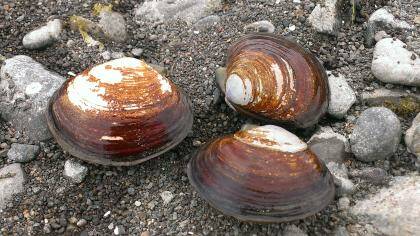Nearly all of Whidbey Island remains closed to butter clam and varnish clam harvest as a result of a paralytic shellfish poison bloom from 2021, the state Department of Health reported.
Recent testing of sample clams of the two species showed high levels of marine biotoxin were present, the state reported. Butter and varnish clams can retain toxins caused by paralytic shellfish poison — commonly known as red tide — for up to a year or more.
The Department of Health reported that beaches on the west side of Whidbey Island, the Saratoga Passage, Penn Cove and Holmes Harbor are all closed to the species of clams. Public beaches throughout Island County are posted with the closure.
The beach closure map on the Department of Health website shows Ala Spit on North Whidbey as the only public beach on the island open to harvesting varnish or butter clams. The two types of clams store toxins longer than other species. Varnish clams, which are often purple on the interior shell, are an invasive species that also concentrate biotoxins at a higher level than other clams.
The bloom that caused the current beach closures occurred in August and September of 2021.
The beaches closed for the two species of clams may be open to harvest of other marine species. The Department of Health urges people to check the beach closure map at fortress.wa.gov/doh/biotoxin/biotoxin.html or call the hotline at 1-800-562-5632.
Crabs are not on the closure list but the state warns that crabs should be cleaned before cooking and the “crab butter” found under the shell should be removed.
According to the Department of Health, marine biotoxins are poisons that are produced by certain kinds of microscopic algae that are present in marine waters, normally in amounts too small to be harmful. A bloom occurs when a combination of warm water, sunlight and nutrients causes rapid plankton reproduction.
The clams and other filter feeders ingest the algae and the toxins accumulate in their tissue.
Symptoms of paralytic shellfish poisoning can appear in minutes to hours. Symptom can begin with tingling lips or tongue, move to hands or feet and then affect breathing. The poisoning is potentially fatal.
“We are optimistic biotoxin-related harvest restrictions can be removed from some beaches in the coming months,” said Tracie S. Barry, marine biotoxin specialist with the Department of Health. “However, we can’t rush nature. Please be patient and do not put your life at risk by harvesting shellfish in an area closed for biotoxins.”



